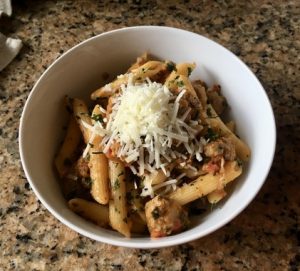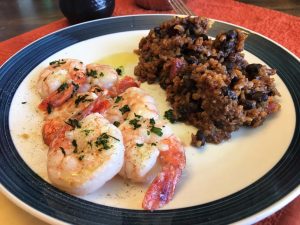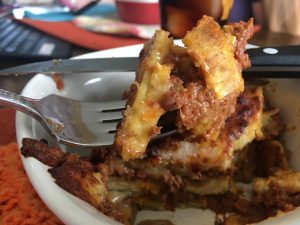Quarancuisine: The Wonders of Wastelessness
If you’ve so much as breathed near a copy of the New York Times in the last five years, congratulations—you’re currently the proud ignorer of approximately 1.6 million emails from NYT Cooking, and that’s assuming they’ve only made their insidious way into one of your email addresses. If, like me, you make it a point to keep a few around, you can’t so much as think about food without Sam Sifton popping into your inbox to tell you about what he and all of his friends made in their gorgeously-appointed kitchens over the past week.
Here’s the thing you need to understand: I hate Sam Sifton.
I hate that he thinks a grilled cheese with duck leg confit, apple slices, some mustard sauce and duck fat fries on the side is a simple weeknight dinner you can just throw together with stuff in your kitchen. I hate that he opens these emails by telling you about spending a week in the middle of nowhere in Maine and cooking with fresh lobster, which everyone should do if they can afford it. I hate that, since we’ve all had to stay at home, he’s only had more time in which to develop a faux-folksy take on recipe-less cooking. Most of all, I hate the fact that I have tried to unsubscribe from this infestation of bubbly food positivity maybe half a dozen times and gotten nowhere.

Why am I getting on this particular soapbox? Well, because I’ve been doing a lot of cooking over the past few weeks. Some of you already know how much I like slinging pans. Since lockdown means limited opportunities to grab ready-made food, especially if you’re on a budget, I’ve been cooking breakfast, dinner, and sometimes even a fresh hot lunch.
At first, when we still had no idea for how long we’d be staying home, it was a matter of throwing together anything we had lying around. We made use of the stuff we’d frozen for future lunches: a quart of plantain soup from the upstairs freezer became two no-worry days. I got real good at making refried beans by the pound. (I make mine with ham bouillon and bacon grease, and the result is effortlessly good with almost anything.) There were a few weird cuts of meat I got for experimentation, and they all got exposed to varying degrees of heat, with generally good results.
Then the freezer stuff ran thin. I knew the homemade spaghetti sauce was in the freezer and it was nicely preserved, but I waited to break it out until we needed only a couple days’ worth of lunches. Toss it in a pan with some oil, revitalize it with some Parmesan, add penne al dente and stir, and boom. Thursday and Friday are settled.
If you’re an assiduous reader of those NYT cooking emails, you may have noticed that my tone, especially at the end there, is growing rather . . . Siftonesque.

After a few weeks, I realized—granted, to my horror—that I was beginning to wax poetic about cooking in a way I simply hadn’t done in a long time.
Several of my Shield writers will by now have told you about all the free time they have. Well, I had apparently decided that I was going to spend that time finding out the exact limitations of my skills, and then systematically eradicating them. I attempted a blueberry ice cream that didn’t quite come out right, despite being an indigo you could fall into for eternity. (Protip: leave the blueberry skins out. I was given bad advice by someone who will not be named, because I’m the dingus who followed it.) That left me with some egg whites.
You know what uses egg whites? Financiers. They’re a ridiculous little pastry that relies on almond flour and extract, egg white and brown butter, and they’re delicious even when you slightly mess them up, which I did, because I’m not a great baker just yet.

The thing is, it’s fine and dandy to use up pantry staples to make great meals when you can’t hit up the grocery store every day, or if you’re averse to getting a lot of takeout. There is real value in learning different ways to prepare the same things, especially healthy vegetables, so you don’t get bored of them and keep eating balanced meals. We take for granted that we have a zillion different ways to reheat things, but reheating them right is a whole different problem. No one wants soggy roots or brassicas on their plate, or a soup that changes consistency from spoonful to spoonful. It’s worth taking the time to learn to resuscitate stuff you weren’t particularly fond of, so you don’t waste it—a skill plenty of people already have, by professional or economic necessity.
I’m just playing at pantry mastery, which might explain why I let myself pull out all the stops now and again. I tried my hand at congrí—which, everywhere but Cuba, is a dry rice cooked in the broth used to make black beans, and then mixed with them—and, due to a mishap involving where the pot with the broth was left, wasn’t able to carry it off canonically.
But with a little work, the rice came out moist and packed with savory, smoky flavor. It went well with almost anything: the shrimp worked, but so did eggs, and so would have fried plantains, a nice salad, or even that classic frozen vegetable mix, whose surprising sweetness I found myself missing when I couldn’t get it at the store.

Oh, and speaking of fried plantains and things I couldn’t get at the store, it took me a month—a month!—to find frozen tostones, since my local Wegmans doesn’t do a very good job of stocking green plantains, and I wasn’t about to go far afield in search of them. Tostones are a sometimes treat, to be sure, but to a suddenly very homesick Puerto Rican cook? Absolute disaster.
Luckily, the yellow plantains the store did have were perfect for something else: pastelón. I fried them, layered them into a casserole with a flavorful picadillo (ground beef cooked slowly in a mix of aromatics, spices, and tomato sauce until thick) and some mozzarella, and for the next few days, I didn’t miss tostones so much.
So: yes, learn a little survival cooking. It’s nice to have a signature pièce de résistance, but right now, it might be even nicer to be reliably good at making bread, or having a couple ways to make cheap protein happen. Learn your way around those weird cuts of meat fancy chefs use while they’re still cheap. Get acquainted with beans. Half of you will get mad, but: get good at tofu. (Slice it. Sit it in salted boiling water for fifteen minutes. Pat dry. Fry. Season. Thank me later.) Learn how to hash, mash, and bash every vegetable in your fridge until you can make them all taste good.
But when you’re tired of that—and you’ll get tired fairly often—make pesto with anything other than basil. (Garlic scapes, this week.) Fall in love with brown butter, which will happen quickly, and then dust some flounder and make yourself some lightly fried fish filets, or go the sweet route and make blondies. Make a batch of dulce de leche, and make sure not to scrape down the sides, and then make sure to put that on some really nice chocolate ice cream.
The point is, learn to make plentiful food that’ll keep you full and healthy and the kind of food that’ll impress the guests you’ll have in the fall. You owe it not just to them, but to yourself, to come out of all this copious free time with new skills, and what better skill to learn than to feed others?
And if you found this a trip, might I suggest you check out some Sam Sifton?
Intrepid Chef • Feb 11, 2021 at 9:12 am
Homemade butter – that was an interesting quarantine cooking experience. It takes longer than you think – have we become so weak since our forefathers, ahem, foremothers, churned it by hand sitting on the front porch?
And frozen tostones are often in stock at Trader Joe’s!